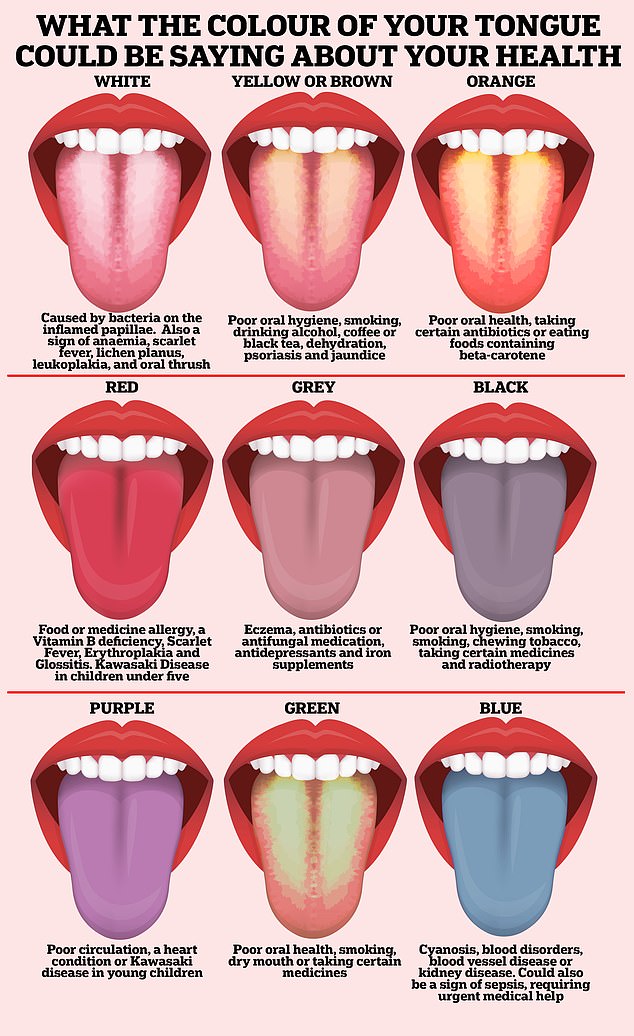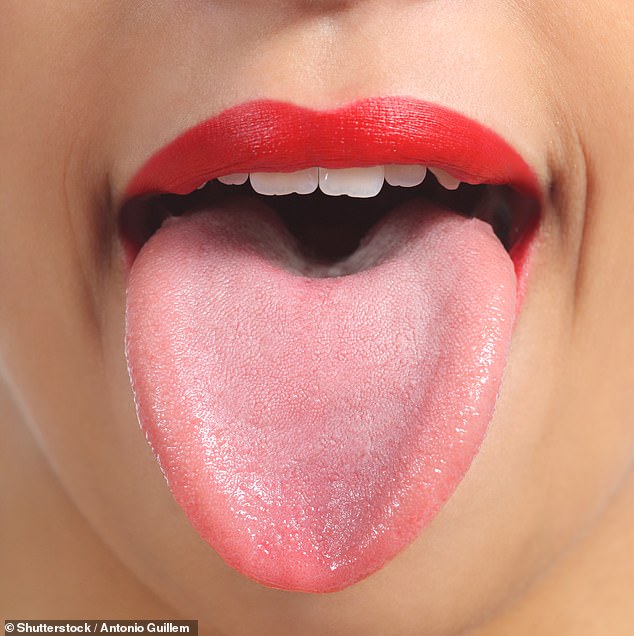A dentist has warned that the color of your tongue can say a lot about your overall health – and ignoring it could put your life at risk.
Dentist Dr. Deepak Aulak says a healthy tongue should be pink with little bumps – or papillae – across the surface.
However, a number of other colors can be signs that a person is ill.
Dr. Deepak, founder of AI-powered dentist app Toothfairy, said: ‘Have you ever noticed your tongue in the mirror and thought, wait, that’s not real?
‘The tongue is an incredible organ – without it we wouldn’t be able to taste, chew and of course speak.

A healthy tongue should be pink with small bumps – or papillae – across the surface. However, a number of other colors can be signs that a person is ill
‘But it’s far more than that, it’s an indicator and any change could be your body warning you that something else is wrong with your health and it’s time to see a doctor.
“It is even a matter of life and death, so it is important that people know the warning signs their tongue is telling them.
‘Colors are always subjective, so talk to a dentist for more information if you feel something isn’t right. ‘
In addition to healthy shades of pink, here are 10 colors your tongue could be, indicating you may be lacking certain nutrients or have become ill.
White tongue
Sufferers will have a thick, white coating on their tongue – it can be across the entire surface, on the back or in patches.
The condition is the result of overgrown or swollen papillae, which can be caused by burning your tongue on particularly hot food or drink.
The ugly white mass is caused by bacteria and dead cells getting stuck between the inflamed papillae.
According to NHSwhite tongue can also be a sign of anemia, scarlet fever, lichen planus, leukoplakia, mouth ulcers and thrush.
Yellow or brown tongue
Yellow or brown tongue is usually an indicator of bacteria as a result of poor oral hygiene, smoking, alcohol, coffee or black tea, per Mayo Clinic.


When the dentist Dr. Deepak Aulak asks his patients to ‘open wide’, he is looking for far more than cavities and gum disease. He will also inspect the tongue.
Products containing thymol, menthol, witch hazel, peroxides and eucalyptus can also cause a yellow coating on the tongue if the mouth is particularly dry.
Dehydration can lead to a yellow tongue, as well as psoriasis and jaundice.
If your face, eyes and tongue all look yellow, it is advisable to speak to a doctor as this could be a sign of liver or gallbladder problems (2).
Orange tongue
Like yellow tongue, poor oral health is usually the cause of orange tongue, although taking certain antibiotics or eating foods containing beta-carotene can be behind it.
Red tongue
Often referred to as ‘strawberry tongue’, a bright red tongue can be a sign of a number of conditions, from vitamin deficiency to disease.
Geographic tongue is a condition that causes the tongue to appear red and create map-like white patches on the surface.
WebMD says that a bright red tongue can also be a sign of a food or drug allergy or a vitamin B deficiency.
Other conditions associated with a red tongue are scarlet fever, erythroplakia – a potential pre-cancerous condition – and glossitis, which causes your tongue to become swollen.
Strawberry tongue can also be a sign of Kawasaki disease in children under the age of five, according to Children’s health.
Gray tongue
Sufferers of geographic tongue may develop gray edges around the red spots on their tongue.
People with eczema have also been known to develop gray tongues.
Another reason may be taking antibiotics or antifungal medicines as well as certain antidepressants and iron supplements, according to Royal Dental Care.
Black tongue
Black hairy tongue occurs when papillae on the surface of the tongue also grow because they do not shed dead skin cells – this causes food and bacteria to get trapped, leading to the unpleasant discoloration.
Often the result of poor oral hygiene, smoking, chewing tobacco, taking certain medications and radiation therapy can also trigger it.
Diabetes and HIV can also cause black tongue, in rarer cases.


Dr. Deepak, This Morning regular and founder of AI-powered dentist app Toothfairy, said: ‘Have you ever noticed your tongue in the mirror and thought, wait, that’s not real? ‘The tongue is an incredible organ – without it we wouldn’t be able to taste, chew and of course speak’
The conditions cause bad breath, a metallic taste in the mouth and a tickling sensation in the mouth.
Purple tongue
Purple tongue can be an indicator of poor circulation, a heart condition or Kawasaki disease, a rare condition that causes inflammation of the blood vessels in young children, per MSD manual.
Green tongue
Similar to yellow tongue, the appearance of a green tongue is the result of poor oral health, smoking, dry mouth, or taking certain medications.
Blue tongue
A blue tongue can be a sign that the person has cyanosis, which is not having enough oxygen in the blood.
That Cleveland Clinic says that causes of cyanosis include blood disorders, blood vessel disease, not enough oxygen from the lungs, or kidney disease.
It can also be a sign of sepsis that requires emergency medical attention.
That NHS advises to call 999 if you or anyone else has pale, blotchy or blue skin, lips or tongue.

